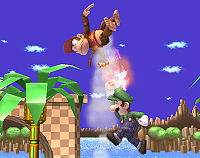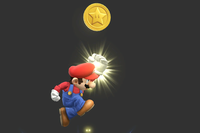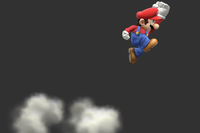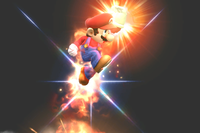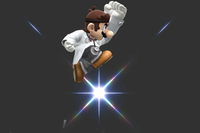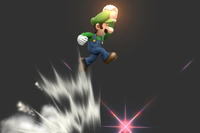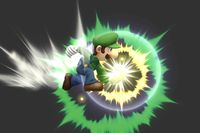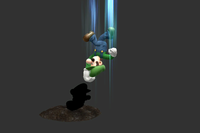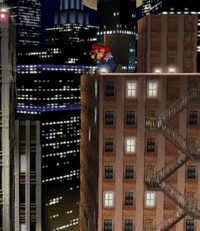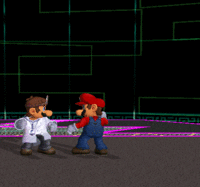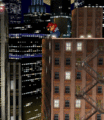Super Jump Punch: Difference between revisions
Sm4shmeister (talk | contribs) (→Luigi) |
Sm4shmeister (talk | contribs) (→Luigi) |
||
| Line 30: | Line 30: | ||
===Luigi=== | ===Luigi=== | ||
[[File:luigi jump punch.jpg|thumb|Luigi's Fire Jump Punch in ''Brawl''.]] | [[File:luigi jump punch.jpg|thumb|Luigi's Fire Jump Punch in ''Brawl''.]] | ||
Luigi's version of the move behaves quite differently from both Mario and Dr. Mario's versions. The move has a rather large [[sourspot]] that deals only 1% damage (releasing a single coin) and no knockback, barely making an opponent flinch at all. However, it has a very precise {{b|sweetspot|hitbox}} right in front of Luigi only at the very beginning of the move, which if it connects turns the move into a powerful '''Fire Jump Punch''' that makes the [[ping]] sound effect, dealing | Luigi's version of the move behaves quite differently from both Mario and Dr. Mario's versions. The move has a rather large [[sourspot]] that deals only 1% damage (releasing a single coin) and no knockback, barely making an opponent flinch at all. However, it has a very precise {{b|sweetspot|hitbox}} right in front of Luigi only at the very beginning of the move, which if it connects turns the move into a powerful '''Fire Jump Punch''' that makes the [[ping]] sound effect, dealing 25% damage with high knockback (enough to [[KO]] at around 60% damage or higher). The Fire Jump Punch if used in the air is slightly weaker than if used on the ground, dealing 20% rather than 25%. It is possible to combo with it by [[short hop]]ping, performing an neutral aerial, and then using a sweetspotted punch at damage percentages around 40% with many characters. Luigi can turn around after the initial hitbox, which will sourspot anyone near him when doing so; however, the usefulness of this maneuver is questionable. | ||
In the original ''[[Super Smash Bros.]]'', Luigi's Super Jump Punch sends him upwards and forwards like Mario, but the horizontal movement after the move is performed is low. From ''Melee'' onward, to distinguish the behavior of the move even further from Mario and Dr. Mario, the move instead sends Luigi directly vertically upward with no horizontal range at all, gaining less height compared to ''Smash 64''. In ''Melee'' specifically Luigi would fall straight down after he finished rising, forcing him to rely entirely on his then-newly added [[Green Missile]] and his [[Luigi Cyclone]] for horizontal recovery. From ''Brawl'' onward, for comedic and aesthetic effect Luigi falls upside-down after performing the move, becoming [[helpless]]; this allows him to steer himself horizontally while falling at the cost of more landing lag, unlike the old helpless state. It covers greater vertical distance than Mario's (in ''Melee'' and ''Brawl'') and Dr. Mario's respective versions. It gains even less distance than before in ''Smash 4'', but has more power to compensate for this, much like how much power it had in ''Brawl'' compared to ''Melee'''s version. | In the original ''[[Super Smash Bros.]]'', Luigi's Super Jump Punch sends him upwards and forwards like Mario, but the horizontal movement after the move is performed is low. From ''Melee'' onward, to distinguish the behavior of the move even further from Mario and Dr. Mario, the move instead sends Luigi directly vertically upward with no horizontal range at all, gaining less height compared to ''Smash 64''. In ''Melee'' specifically Luigi would fall straight down after he finished rising, forcing him to rely entirely on his then-newly added [[Green Missile]] and his [[Luigi Cyclone]] for horizontal recovery. From ''Brawl'' onward, for comedic and aesthetic effect Luigi falls upside-down after performing the move, becoming [[helpless]]; this allows him to steer himself horizontally while falling at the cost of more landing lag, unlike the old helpless state. It covers greater vertical distance than Mario's (in ''Melee'' and ''Brawl'') and Dr. Mario's respective versions. It gains even less distance than before in ''Smash 4'', but has more power to compensate for this, much like how much power it had in ''Brawl'' compared to ''Melee'''s version. | ||
Revision as of 22:12, July 24, 2017
| Super Jump Punch | |
|---|---|
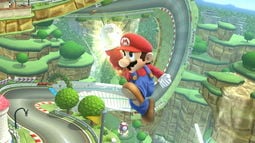 Mario performing his Super Jump Punch in Super Smash Bros. for Wii U. | |
| User | Mario Luigi Dr. Mario |
| Universe | Mario |
| Article on Super Mario Wiki | Super Jump Punch |
| “ | "Attack opponents while jumping or leap to get back to the ledge." | ” |
| —Melee's instruction manual | ||
| “ | "Jump while attacking. Useful in recoveries." | ” |
| —Brawl's instruction manual | ||
| “ | "Jump up to hit opponents multiple times." | ” |
| —Smash 3DS's foldout (Mario) | ||
| “ | "A rising punch that can deal great damage at the start of the move." | ” |
| —Smash 3DS's foldout (Luigi) | ||
The Super Jump Punch (スーパージャンプパンチ, Super Jump Punch) is Mario, Dr. Mario, and Luigi's up special move in each of their appearances in the Super Smash Bros. series.
Users
Mario
When performed by Mario, he jumps diagonally upwards with more vertical range than horizontal. If the attack strikes an enemy during the jump, coins fly out of the enemy, and the foe receives several hits of 1% damage each for up to about 10-13% damage. The coins' appearance is accompanied by the usual sound effect played in the Mario series when Mario grabs a coin. The last hit of the attack deals moderate knockback in Melee, but is more powerful in Brawl, able to Star KO opponents if used near the upper blast line. It is possible to "aim" the move straight up vertically by holding the Control Stick in the opposite direction that Mario is facing during the initial "spark" of the move's animation, and it can be angled more horizontally as well by aiming the control stick or D-Pad forward. Mario can hit opponents with the first hit of the move by aiming in the opposite direction upon the move's start-up, which only does set knockback and minimal damage, therefore having little use.
In the original Super Smash Bros, the move has a great vertical range (enough to go from the main platform of Dream Land to the top platform) and decent horizontal range if aimed forward. From Melee onward this range was reduced, causing it to become an overall rather poor recovery move since it is easily edgeguarded. However, this can be mitigated by the then-new addition of Mario's side special move Cape, which slightly aids Mario's horizontal recovery and makes recovering a little easier. Combining Cape with Super Jump Punch's lightly horizontal and mainly vertical range will give Mario a fair horizontal recovery, though the attack's angle will make it a terrible move to use vertically in some situations below the ledge. In Brawl, the move has much more landing lag.
Dr. Mario
In Melee, Dr. Mario's version of the attack is nearly identical to Mario's, though it is more powerful and scores fewer hits. As with Mario, if the attack hits an enemy, coins fly out and the attack deals about 12% damage. However, the sound effect uses generic "hit" sounds instead of playing Mario's usual coin sound effect. Like Mario, Dr. Mario can also "aim" the move to change its angle somewhat.
In Smash 4, Dr. Mario's Super Jump Punch no longer hits multiple times, instead striking as a sex kick, dealing 13.44% damage at the start of the attack and 6.72% damage for the rest of the move. This can be considered a less extreme version of Luigi's version of Super Jump Punch. This move, if hit clean and aimed in the opposite direction, can potentially hit foes behind him, allowing him to avoid a possible punish after using the move or edgeguard foes offstage and recover at the same time.
Luigi
Luigi's version of the move behaves quite differently from both Mario and Dr. Mario's versions. The move has a rather large sourspot that deals only 1% damage (releasing a single coin) and no knockback, barely making an opponent flinch at all. However, it has a very precise sweetspot right in front of Luigi only at the very beginning of the move, which if it connects turns the move into a powerful Fire Jump Punch that makes the ping sound effect, dealing 25% damage with high knockback (enough to KO at around 60% damage or higher). The Fire Jump Punch if used in the air is slightly weaker than if used on the ground, dealing 20% rather than 25%. It is possible to combo with it by short hopping, performing an neutral aerial, and then using a sweetspotted punch at damage percentages around 40% with many characters. Luigi can turn around after the initial hitbox, which will sourspot anyone near him when doing so; however, the usefulness of this maneuver is questionable.
In the original Super Smash Bros., Luigi's Super Jump Punch sends him upwards and forwards like Mario, but the horizontal movement after the move is performed is low. From Melee onward, to distinguish the behavior of the move even further from Mario and Dr. Mario, the move instead sends Luigi directly vertically upward with no horizontal range at all, gaining less height compared to Smash 64. In Melee specifically Luigi would fall straight down after he finished rising, forcing him to rely entirely on his then-newly added Green Missile and his Luigi Cyclone for horizontal recovery. From Brawl onward, for comedic and aesthetic effect Luigi falls upside-down after performing the move, becoming helpless; this allows him to steer himself horizontally while falling at the cost of more landing lag, unlike the old helpless state. It covers greater vertical distance than Mario's (in Melee and Brawl) and Dr. Mario's respective versions. It gains even less distance than before in Smash 4, but has more power to compensate for this, much like how much power it had in Brawl compared to Melee's version.
The move's sourspot may seem useless; however, in Time matches it can be used to steal KOs, as it will give Luigi the last hit on the opponent without changing their trajectory. Additionally, in Melee the Luigi Ladder can be performed, where two Luigis can repeatedly hit each other with the sourspot of the attack to rise indefinitely, even above the upper blast line.
Customization
Special Move customization was added in Super Smash Bros. 4. These are the variations:
Mario & Dr. Mario
| 1. Super Jump Punch | 2. Super Jump | 3. Explosive Punch |
|---|---|---|
| "A rising punch that hits repeatedly." | "More jump than the Super Jump Punch, but with none of the punch." | "Less jump than the Super Jump Punch, but with an explosive punch at the top." |
| 1. Super Jump Punch | 2. Super Jump | 3. Ol' One-Two |
|---|---|---|
| "This rising punch may have no coins involved, but it's extra powerful at the start of the jump." | "A slow jump that travels higher. No attack power, but you can move horizontally." | "A burning uppercut. Not much height, but causes a powerful explosion at its peak." |
- Super Jump Punch: Default.
- Super Jump: Deals no damage, but has less startup, increases the distance travelled, and has a wider range of angles. Rises faster when used in mid-air. While Mario's Super Jump further increases recovery distance, Dr. Mario's Super Jump travels about the same distance as Mario's Super Jump Punch. Has slightly more ending and landing lag, but Mario's momentum is not halted at the end of the move as much.
- Explosive Punch (Mario) / Ol' One-Two (Dr. Mario): Produces fire and explosive damage. It now does only two hits, 8% damage for the first hit and 13% damage for the second. A powerful KOing option, killing at around 96% from the ground. However, recovery distance is reduced, and the move can't be angled at all. The move has drastically increased ending lag, meaning Mario cannot be controlled for a long time after the move ends, and it also has slightly increased landing lag.
- In Super Smash Bros. for Nintendo 3DS, this variation is a Challenge unlock for Mario, only obtainable by getting a score of at least 200,000 in Target Blast.
Luigi
| 1. Super Jump Punch | 2. Fiery Jump Punch | 3. Burial Header |
|---|---|---|
| "Punch up through the air. Stronger at the start of the move." | "Easier to get a critical hit at the start, but you don't jump as high." | "Can bury opponents on the way down, but no critical hits on the way up." |
- Super Jump Punch: Default.
- Fiery Jump Punch: Sweetspot is larger and easier to hit with, but weaker. Both grounded and air versions lack the distinctive ping sound. Doesn't rise as high and has much more ending lag.
- Burial Header: Loses the sweetspot but gains a new attack after the initial jump - Luigi falls much faster and can bury grounded opponents, allowing for potential follow-ups. With good positioning, the sourspot can combo into the descending hit at high percents or knock opponents away. Sends Luigi higher than his other up specials. Also has much less ending lag.
Mario using the Super Jump in Super Smash Bros. for Nintendo 3DS
Mario using the Explosive Punch in Super Smash Bros. for Nintendo 3DS
Origin
The Super Jump Punch is based on the most simple technique used by the Mario Bros.—the jump. In the original Super Mario Bros. and many games afterward, Mario and Luigi jump to cross gaps, stomp on enemies (such as Koopa Troopas and Goombas), and break bricks or hit blocks to reveal coins or power-ups (such as Super Mushrooms and Fire Flowers).
The Super Jump Punch is based on Mario and Luigi's ability to reveal multiple coins from certain blocks by jumping due to holding their fists upward; these coins are seen when Mario, Luigi (when sourspotted only), and Dr. Mario (in Melee only) use the attack on a foe. Coins are the currency of the Mushroom Kingdom in the Mario series. The coins that appear use their design from Super Mario 64 up until Super Smash Bros. 4, where their design was updated to resemble the Star Coins from the New Super Mario Bros. series of games. The sound effect played at the beginning of the move (by all three users) is based on the sound effect played when Mario or Luigi jumps in Super Mario Bros.
Techniques
Super Jump Punch wall jump
In Melee, if Mario is right next to a wall, the Super Jump Punch can be cancelled into a wall jump by tapping the opposite direction Mario is facing immediately after Mario begins to turn around after reaching the apex of his jump. This technique can be rather useful if Mario happens to be knocked very low while next to the wall on stages such as Yoshi's Story (such as when recovering from a meteor smash). It isn't easy to utilize however, due to requiring Mario to be right next to the wall before using the move.
Up-B cancel
In Melee, Dr. Mario can cancel his Super Jump Punch. To perform this, a player must have Dr. Mario use his Super Jump Punch and then during the first four frames, quickly move the control stick in the opposite direction. Alternatively, the player can use Super Jump Punch such that Dr. Mario would jump backwards, and then press the control stick downward during the first few frames of the animation. This technique can be used for combos (similar to Fox's Reflector) or to shield cancel and punish the opponent for approaching or for trying to break the player's shield; however, its set knockback means that it cannot KO opponents.
Gallery
- JumpSMB.jpg
Mario's jumping animation from Super Mario Bros.
Mario's Super Jump Punch on Ness in Melee.
Mario's Super Jump Punch in Super Smash Bros. for Nintendo 3DS.
Luigi's Super Jump Punch in Super Smash Bros. for Nintendo 3DS.
Luigi's Super Jump Punch in Super Smash Bros. for Wii U.
Dr. Mario's Super Jump Punch in Super Smash Bros. for Wii U.
Trivia
- In Melee, the coins for the Trophy Lottery as well as the "Game Over" screen look very similar to the coins that appear when using this move. This carries over to the Game Over screen in Brawl's Adventure and Classic Modes, as well as the Coin Launcher. Lastly, there is a Coin trophy in Melee.
- This move is occasionally nicknamed as "Pay-Day Punch", given that Nintendo Power magazine gave this name to the move in its review for Super Smash Bros., referring to the coins flying out of the enemy when dealing damage. This is a reference to the move Pay Day in the Pokémon games, which also causes coins to spawn.
- Prior to Smash 4, the coins that appear are 2D sprites that always face the screen on the pause menu.
